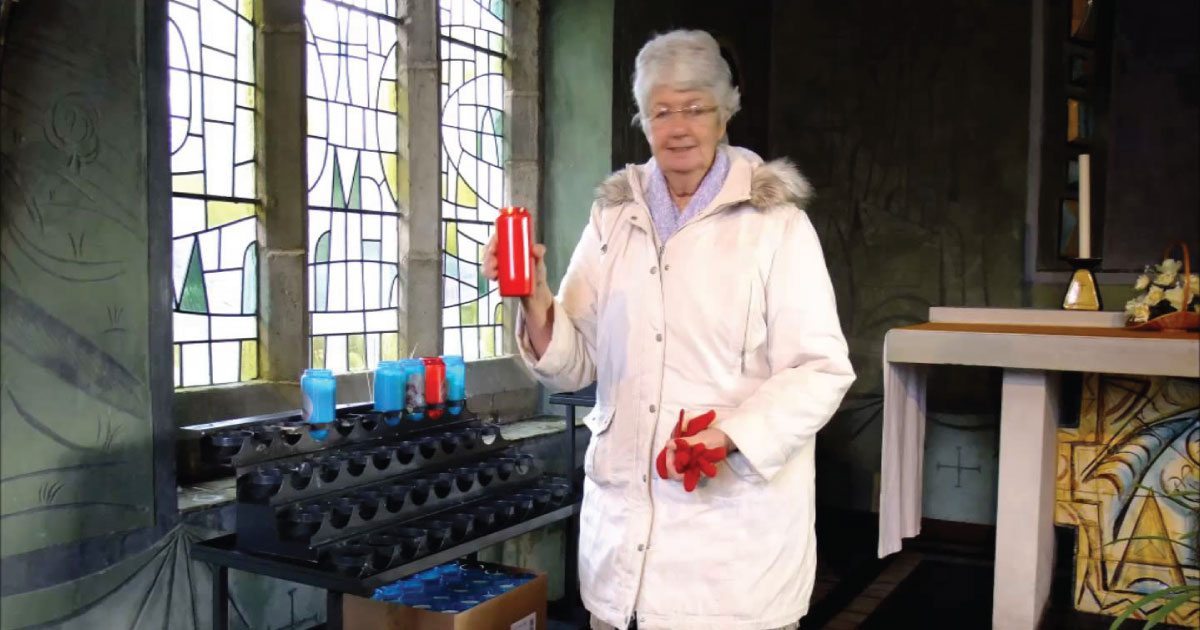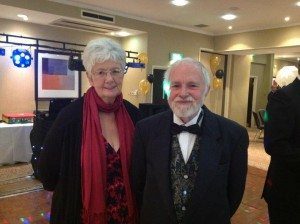Month: December 2013

Mavis Nye Finds Her Voice and Fights for the Mesothelioma Community
Last week we shared Mavis Nye’s story as she fights pleural mesothelioma. In that article we shared the humor and love of life that has kept Mavis going strong. However, she also has a fighting spirit and works tirelessly to spread the word of the dangers of asbestos. In Part II of Mavis’s story, we talk about her efforts to educate the public.
Mavis Nye said that sometimes it feels like she lives her life in three month blocks. That is the length of time between each of her CT scans where her oncologist can determine whether her treatment is effective. Prior scans showed she was keeping the cancer at bay. However, her last scan showed some regrowth of the tumors.
“I have had so many scans and tests that I know that mesothelioma is the only thing wrong with me,” Mavis told Mesothelioma Help in a recent e-mail interview. If not for the cancer, “I could have lived to 99 like my mother did. That makes me so sad.”
It is this sadness and frustration that leads Mavis to do all she can to let everyone know that asbestos is extremely dangerous and to fight to shield future generations from this “nasty cancer” — a cancer she developed by inhaling microscopic asbestos fibers that clung to her husband Ray’s clothes that he brought home from his work at the dockyard.
The Prolific Writer
Within months after Mavis’s diagnosis she began to connect with other patients who were also struggling to make sense of the disease. Through social media, Mavis found a support group of mesothelioma warriors who had been through treatments and had joined forces to educate the public about asbestos and this terrible cancer. Via Twitter, @GrandmaMavis slowly began to post articles about newly discovered asbestos hazards, safety violations and medical breakthroughs. On Facebook she “liked” articles sent by others, sent affirming thoughts to patients struggling through treatments and the side effects, and shared information about clinical trials and upcoming medical conferences.
During this time Mavis became more knowledgeable about the disease, and she became more frustrated. She was determined to capture her story, as it unfolded, and what she has learned along the way. She became a prolific writer and she and Ray have made virtually every step of her diagnosis and care available to the public.
Mavis and Ray both maintain a daily blog. They leave their readers both laughing and crying as they follow their ups and downs, struggles, and highlights of their days. Mavis’s trademark humor and Ray’s adventures as a caregiver, and sometime patient himself, present a clear picture of how mesothelioma affects more than just the patient.
The two also created and manage OneStop Mesothelioma, a website that contains information they have gathered about asbestos, mesothelioma, medical resources, and even heart health. (Ray suffered a heart attack this year, and he offers readers information about angioplasty and stents.)
http://onestopmesothelioma.co.uk/index.html
In 2010, Mavis published her book, “Meso Warrior” to share her story and to “give other mesothelioma sufferers the insight that it’s not all doom and gloom.” All proceeds of her book go to Mesothelioma UK to help raise funds for research.
http://www.mesothelioma.uk.com
My Name is Mavis and I Have Mesothelioma
The first time Mavis spoke publicly about her story and about the disease was at the 2010 Mesothelioma UK Conference in London. There, she was able to tell her story of her mesothelioma diagnosis and treatment.
“I was nervous in case I made a mistake,” said Mavis, “but I got through it and I was surprised by the clapping.”
Once Mavis got started there was no slowing her down. She has been interviewed by national magazines, including Yours, a UK women’s magazine, and by local newspapers, local radio and TV stations, national papers, and international organizations. She has spoken at many more conferences, and starred in a safety video by the British Lung Foundation. She has even taken her fight to the British Parliament.
Mavis has also been awarded for her efforts. Among her honors is the 2013 Asbestos Disease Awareness Organization’s Alan Reinstein Award for her commitment to education, advocacy, and support to countless patients and families.

IATP 2013 Meso Warrior Award
Her proudest moment was when she was awarded the 2013 Independent Asbestos Training Providers’ Meso Warrior award. Mavis spoke for just a few minutes when she accepted the award, but her heartfelt words about her journey earned her a standing ovation, and left the room in tears. It was having Ray, her son, Terry and his wife, Nicky, in the audience that moved Mavis the most.
Forwarding Treatment
Now, one of Mavis’s favorite and most rewarding advocacy efforts is that of a patient representative at the Cancer Network in East Kent. As a multi-year survivor, Mavis has been called on to discuss mesothelioma treatments available, or soon to be available to the community. Others in the group include doctors, nurses, and pharmaceutical representatives.
“I have to fight for mesothelioma to be heard, as they discuss other cancers,” said Mavis. “At the Lung Disease Orientated Group (Lung Dog) I have to keep asking about clinical trials as there are so many for lung cancer, but our cancer is not really lung cancer as such it is the cancer of the pleura that cover the lung.”
Mavis knows there is no cure for mesothelioma, and she believes there may never be, but through her effort to support and promote the implementation of improvements in cancer care at Kent, she hopes to make a difference for other patients.
“We all hope there will be a wonder drug come out and save us like a knight on a white stallion,” Mavis wrote in a recent blog entry.

Father Lost to Mesothelioma Made Daughter Closer to Her Mother
Anytime you lose a loved one, relationships between those who are left behind change. In my case, I became closer with my family (who is already extremely close) as I need them more now than ever before. My relationship with Mom has deepened a lot over the last few years. I have always counted her among my best friends, but once Dad got sick, our relationship grew to a whole new level.
Once we became caregivers for Dad, Mom and I started to talk a lot more frequently, usually several times a day, to check in and see how things were going and what Dad needed. She not only took amazing care of Dad, she had to take care of me too. I am a complete worrier, you can ask anyone! The time we spent waiting for doctor appointments or test results were complete torture for me. She and Dad were always there to calm me down, even though they needed comforting themselves.
Now that Dad is gone, no longer sick and suffering, Mom is working on slowly figuring things out. Everything has changed for her, and I must say she is doing an unbelievable job coping with the situation. I have written before about how strong she is, and that strength continues to shine through every day.
My husband has also assumed a new role in taking care of Mom and me. Every time we visit (which is pretty often), he always tackles the projects around the house that need fixed, moving things around, answering questions… and he does all of these things with a smile and so much grace. He does it because he knows that we all need each other. This is what family is all about.
Mom continues to amaze me every day, and I am blessed to have her for my mother just like Dad was blessed to have her for his wife for almost 32 years. Our relationship grows stronger every day and we know that we can always count on one another. The mother-daughter relationship is a special one, and it’s easy when you have a Mom as special as mine.
Know more about Mesothelioma and how you can deal with it.

Mesothelioma Survivors Learn to Manage Their Chronic Condition
Recently, I was talking to a patient who has been battling mesothelioma for the past 3.5 years. During our conversation it struck me that in his case mesothelioma has become a chronic condition that he is now living with. The good news for him, and other long-term survivors of mesothelioma, is that progress has been made. Mesothelioma treatment is prolonging some people’s lives past the grim statistics of survival with mesothelioma.
According to the U.S. Centers for Disease Control and Prevention, cancer is the second leading cause of death in the United States, exceeded only by heart disease. In 2010, nearly 575,000 people died of cancer, and more than 1.45 million people had a diagnosis of cancer. Mesothelioma comprises approximately 1% of these cancers.
What does it mean to have a chronic condition? About one- fourth of people with chronic conditions have one or more daily activity limitations. Chronic diseases are the leading cause of death and disability in the U.S. Heart disease, cancer and stroke account for more than 50% of all deaths each year.
For this mesothelioma survivor, what living with mesothelioma means to him is dealing with pain, recurrences, infection, chemotherapy, and radiation. It has been a difficult road for both him and his wife. They have spent countless hours at appointments with many doctors, have endured too many procedures, and have ridden the proverbial roller coaster with their emotional highs and lows. Yet, through it all, he has seen another grandchild born, and has enjoyed many special times with his family. Would he do it again? Today he would, but ask him on his down days and he might not be so sure.
As you give thanks during this holiday season make sure to include the mesothelioma patients that are forging ahead and blazing a trail as the search for a cure for mesothelioma continues. No one mesothelioma patient is a statistic, they all have stories that we are privileged to hear. Thanks to all of the mesothelioma survivors for their courage and inspiration.
Know more about Mesothelioma and how you can deal with it.

Mavis Nye Fights Mesothelioma with Laughter and Love
Mavis Nye of England shares her inspiring story of her ups and downs while fighting pleural mesothelioma. Through an email interview with MesotheliomaHelp, Mavis discussed how she takes on her cancer the same way she lives her life – with humor and through support from her family.
They say “laughter is the best medicine,” and for 72-year-old Mavis Nye that may be just the case. Mavis, of Seasalter, England, has been battling pleural mesothelioma since 2009. Although she has had her share of bad days, Mavis laughs a lot, makes fun of herself and even jokes about dying. It is this lighthearted approach to the serious, terminal cancer that has kept Mavis and her husband, Ray, enjoying their golden years.
“I have found that I have laughed a lot,” said Mavis. She believes that not only does humor help her and Ray better cope with her disease, but, she said, “I think it makes it easier for people to talk to me and not shy away not knowing what to say.”
Don’t let her humor fool you though – Mavis is a very serious and tenacious fighter when it comes to keeping herself alive and happy. She and Ray just celebrated their 53rd wedding anniversary, and she plans to celebrate many more years with the man who stole her heart when she was just 16 years old. She also wants to be there for her sons, Tony and Terry, her daughters-in-law, and her three grandchildren, who have put their lives on hold and rallied around her throughout her mesothelioma ordeal.
When Mavis was first diagnosed with mesothelioma, after experiencing difficulty breathing and numbness in her arms, she was told that she had just three months to live. Now, four and one half years later, Mavis is happy to say she has been controlling her destiny as much as the medical team that has been treating her.
Preparing for the Battle
Like a fighter heading into the ring, Mavis began preparing for the fight of her life on June 4, 2009, the day she heard the devastating news. In her June 12, 2009 blog article Mavis noted that she was already planning her fight: “I have a real battle on my hands, but with all these lovely wishes, I will fight— I promise.”
“Don’t think I’m sitting about like an invalid,” Mavis wrote in her blog just days later. She “tidied the garden and laid a little patio in a quiet place so I can sit and read when I’m on chemo.” She cleared out the shed of “stupid things we collect,” and began packing for a weekend camping event. Then, she added, “I have gone on the dog walk this week, 2 miles every day, as exercise will build the lungs — so you see I’m ready for this fight.”
Mavis needed that fighting spirit for the long road ahead. She has endured surgery, radiation, chemotherapy, a clinical trial and countless procedures and tests. And she is still looking for that silver bullet that will rid her of the cancer that has invaded her body. Mavis just completed a fourth round of chemotherapy treatment. Her doctors weren’t sure whether to proceed, but knowing Mavis’s strength and will, this summer they went ahead with six sessions.
Home Away from Home
Since Mavis’s initial treatment, a talc pleurodesis surgery where a talcum “slurry” was inserted in the pleural layers to seal the space so no further fluid could accumulate around her lungs, she and Ray have continued to do what they enjoy most – joining friends at an RV rally or kicking back for a few days of camping. After her first procedure, when she was still weak, Mavis and Ray packed up their motor home, grabbed their loyal dog Louis, and headed out for some R & R.

Since then, the two have barely missed an invitation to meet up with their friends from their “motor homer’s club.” And that time together has only strengthened the couple’s already unshakeable bond.
“Ray and I enjoy doing so much together,” said Mavis. “We are laughing all the time and enjoy camping together in the motor home. That’s when we can really relax.”
When they aren’t in their RV, the two are busy planning their next trip. Whether it is another country in Europe, a party in the next town, or a day of shopping, Mavis and Ray are buoyed by their excursions. They see each day as an adventure, and it also happens to be the best way for Mavis to cope with her mesothelioma.
“There have been some very bad days when in chemo, and the sickness and pain has been intolerable, but on those days I just lay back and rest knowing that the chemo was working on my Mr. Nasty.”
When asked what it is that gets her out of bed every morning, Mavis said simply, “I love getting up each day because it is a new start, a fresh start and I will see another day. Laughter and great friends and the love of life are what keep me going.”
Below are Mavis’ and Ray’s websites:
- OneStop Mesothelioma – Contains information and resources about mesothelioma and asbestos
http://onestopmesothelioma.co.uk/index.html - Living with Mesothelioma – Mavis’s Diary
- Ray’s Blog
- Meso Warrior – Mavis’s book available on Amazon.com
https://www.amazon.com/Meso-Warrior-Mavis-Nye-ebook/dp/B004EHZXL6
Come back next week for Part IIof Mavis’s story – her advocacy.

Mesothelioma Nurse Explains Importance of Taking Prescribed Medications
Mr. W is an intelligent, 62-year-old man who recently had a pleurectomy for treatment of his malignant pleural mesothelioma. His post surgery course was smooth, with no unusual complications. He has a very supportive wife and children. He seemed to understand the importance of following the post-op instructions. He was enthusiastic about walking, understood and complied with his fluid restriction, knew his medications, and pain was not an issue.
His beta blocker, ASA, lasix, and magnesium, had all been reviewed with him, and he had taken some before his surgery and immediately after discharge from his surgery. Knowing all that, and the support he had from both his family, and his home primary care physician who had referred him to the mesothelioma center, why then, when he got home, did he stop taking all his medications?
Adherence refers to how consistently a patient takes his medication exactly as prescribed. The reasons people don’t take their medicine as prescribed are varied: the patients do not want to deal with the side effects; patients don’t feel well enough to take them; they can’t see the benefits of the medication; or the cost of medications is an issue.
Another reason may be that the patient simply forgets to take meds as prescribed. Still other patients are actually in denial believing if they take the medicines then there really is something wrong with them. Yes, your cancer is real. But taking your medicines can help you fight it.
Studies have shown that for patients with chronic conditions like high blood pressure and diabetes the non-adherence rate can be as high as 50%. Cancer has now progressed to a chronic disease, and with that distinction comes other issues.
In asking Mr. W why he stopped his meds, he did not really have an explanation. He had not discussed it with either his family or his health care team. Intellectually, he knew the reasons and importance of taking his medications, but he stopped taking them. Upon further discussion with him, though, he revealed his depression with his cancer diagnosis. He agreed to talk to his PCP and get some help.
Adherence to the treatment plan is important in the care of all patients, especially mesothelioma patients. Nurses realize that every patient is different and every circumstance might not be what it appears. Being open and honest with your health care team is vital to ensure that your mesothelioma is being treated according to your needs.
If you have questions about your mesothelioma treatment or any aspect of your mesothelioma care, feel free to contact us.
Free Mesothelioma Patient & Treatment Guide
We’d like to offer you our in-depth guide, “A Patient’s Guide to Mesothelioma,” absolutely free of charge.
It contains a wealth of information and resources to help you better understand the condition, choose (and afford) appropriate treatment, and exercise your legal right to compensation.
Download Now